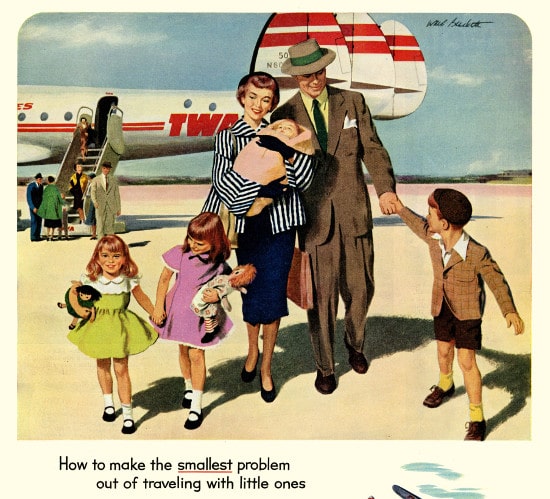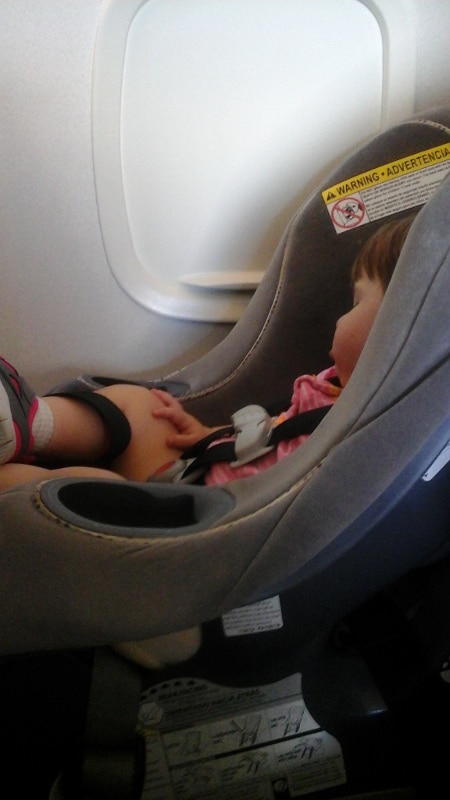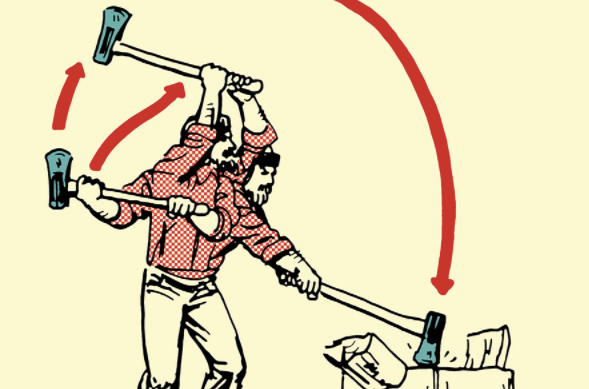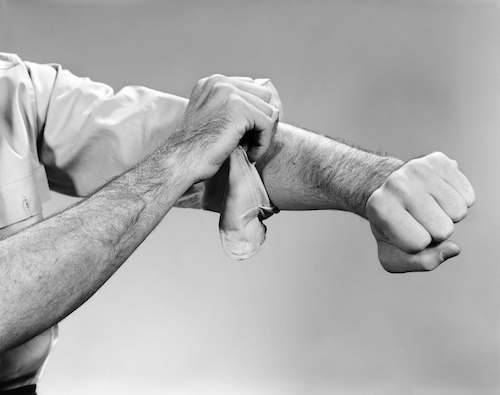
Last week the McKay clan ventured to Vermont for a week-long vacation. It was our second family vacation with kids, and our first with Scout, who is a little over a year old.
While I always look forward to vacation, the getting there makes me a little anxious. Because I really, really don’t want to be that guy. You know, the guy with kids who are howling on the plane as his fellow passengers cast murderous glances in his direction. I know when I fly solo I enjoy a nice, quiet flight, and I’d hate to disrupt the peace of others. And of course, in addition to irritating one’s fellow travelers, wailing tykes are uber stressful for the parents themselves.
So in preparing for our trips I read up on various ways to increase our chances of having a smooth flight with babies and toddlers in tow. The methods we decided to implement worked quite well – on both vacations the kids flew with almost no caterwauling whatsoever. Below you’ll find the tips that proved successful:

1. Book the shortest route/flights you can (but be sure there’s a comfortable layover)
The less time your kids have to spend on the plane, and the quicker you can get to your destination, the better. Sites like Kayak.com can help you sort potential flights by travel time so you can find the shortest flights and routes.
If you’re booking a multi-leg trip, however, be sure there is a comfortable layover between flights. Hauling through the airport to get to a connecting flight on time isn’t easy when you’re flying solo; dragging a baby and toddler at top speed is an even harder task. Having at least an hour or so between flights also gives kids a break from the plane and a chance to stretch their legs, get something to eat, have their diapers changed in a bathroom that isn’t the size of a coffin, etc.
2. Book the flight to coincide with their naptime
The ideal outcome when you’re flying with a baby is that they’ll sleep for most of the flight. To up the chances of this happening, book your flight so it coincides with their usual naptime (and then pray that there’s no delays!).
If you’ll be taking multiple flights, aim to have the longest leg of the journey coincide with their nap.
3. Choose a seat by the plane’s engines
The best place to sit on a plane with kids is debated by parents. Some like the bulkhead because of the extra legroom, and the fact that they can be some of the first to get off the plane once it lands. Some planes, especially for international flights, also have bassinets your baby can sleep in that attach to the bulkhead. But the big downside of choosing this option is that you can’t have your carry-on bag by your feet during take-off and landing, and you’re going to be stressing if the kids are wailing and you need something but can’t get it.
Other folks recommend the back of the plane. It’s sometimes less populated, so you have less chance of bothering others. Plus it’s near the lavatory in case you and your kids need to use it. The back of plane is also less affected by turbulence, helping your child sleep more soundly.
The golden recommendation I got from a flight attendant is to seat your kids wherever the plane’s engines are. The engines create a din of white noise that will help knock your kids out. It may seem loud, but the womb was incredibly loud too – they’ll think they’re back in their happy place. The placement of the engines varies from plane to plane. Figure out the type of plane you’ll be flying in, and then do a google search to see where the aircraft’s engines are located. You can also check seatguru.com for more details about the seating arrangement of the plane.
One thing to keep in mind when the engines are at the back of the plane is that’s where the lavatory is, too. If you sit in the very last row, you’ll find that the sound of people unlatching the bathroom lock is surprisingly loud, and it may rouse your baby from his slumber. So you might want to sit a few rows up. Plus, lavatory smell.
4. Book your kid his own seat

And…I’m back in the womb.
Airlines in the US let children under the age of 2 sit on their caretaker’s lap. The advantage to this is obvious: you don’t have to buy them their own seat and you’ll thus save a lot of money.
But while it may seem hard to justify coughing up the cash to buy your tiny tot her own high-flying throne, if your budget will allow it (some airlines offer a discount on children’s seats – be sure to check), I definitely think it’s worthwhile. When your kid has an assigned seat, you can bring along her car seat and strap her in just like you would in a car. This has several distinct advantages.
First, it’s much safer. A baby held on a lap can be injured if the plane is hit with severe turbulence.
Second, it’s a heck of a lot more comfortable for both baby and parent. After they’re a few months old, many babies won’t sit placidly in your arms — they’ll try to squirm out and slide down, and continually restraining them just makes them scream. Our babies never fell asleep in our arms, even if they were tired. If you’ve got a wide-awake baby that won’t sit still, you’re in for a long flight, friend. Even if they do fall asleep, with your arms occupied, you’re going to be stuck staring at the tray table in front of you for two hours. But if the kid’s in their car seat – something they’re already used to from driving around town – they’ll feel more at ease and are more apt to fall asleep. While they’re snoozing, you can read and relax.

A man should never used wheeled luggage. Exception being when it contains a live human.
Third, while lugging a car seat around the airport sounds cumbersome (and definitely is when you’re doing things like going through security), if you get an attachment like this one, you can wheel the seat around – kid strapped in it – just like you would rolling luggage. This makes it very easy to trek through the airport with them. These walks are also quite soothing for them and a good way to get them to go to sleep if they’re in need of a nap (during say, an unexpected flight delay).
If you do decide to go the “lap infant” route, try to book an aisle seat and a window seat; that way, if no one sits in the middle, your child may be able to sprawl out and lie down. If someone does book the middle seat, you can usually persuade them to switch with one of you if you’d like to sit next to your wife. Also keep in mind that you may be asked to furnish your child’s birth certificate or passport when you check in to prove they’re under 2 years old.
5. May I recommend “the travel jacket”?

Several years ago the nice folks at J. Peterman sent me their Victoria Falls Jacket right before a trip of mine to NYC. I brought it along and was quite smitten with how practical and handsome it was. (Not as handsome as a suit and fedora, of course. But neither was my ride outfitted like a spacious 1950s TWA airliner.). Its many pockets really come in handy. Plus donning it makes me feel like I’m all set for an adventure. I affectionately dubbed it “the travel jacket” and it has accompanied me on all subsequent trips. It has proved even more handy for traveling with kids; they need all sorts of accouterments that I stash in the pockets for easy access. And it doubles as a blanket if they get cold. So I highly recommend getting yourself a lightweight, multi-pocketed jacket for your travels.
6. A spoonful of Benadryl helps the baby go down
I imagine the idea of slipping your kid a little Benadryl before a flight may be controversial. Plenty of adults take a little something – Paxil, a shot of Jack Daniels – to take the edge off the unpleasantness of flying, but it may seem inappropriate or dangerous to medicate one’s child.
But, I highly recommend it. Not only will Benadryl help your tot snooze during the flight, but by opening up the nasal passages and Eustachian tubes (which adjusts the air pressure in the middle ear) their ears have a greater chance of popping painlessly (more on this below).
Just make sure you do it safely. To get an expert opinion on this subject, I asked pediatrician Michael D. Austin, MD for his advice, and this is what he told me:
We don’t encourage the general sedation of kids. But planes are the exception. Try a test dose before the trip, as 5% of children get a paradoxical “hyper” reaction; that is, the Benadryl makes them feel more irritable and jittery, rather than less.
It is usually best only to give Benadryl to children above 12 months old. Those younger than 12 months have greater side effects, and variable sedation.
It’s best to just give one dose. That is, if on an international flight or cross-country drive, you don’t want to continuously sedate the child.
Give them the dose about 30 minutes before the plane takes off. Benadryl often sedates for 4-6 hours, so be aware you may be carrying your groggy child off the plane and plan accordingly.
If they sleep (due to Benadryl) during a normal awake period it may affect their regular sleep schedule, so while you are ready to “crash” at your destination, your child may be wide awake.
The above two issues mean that for my kids we only gave Benadryl when we clearly anticipated a fussy child, and not routinely. There are other ways to keep a child occupied on a trip, so while I find using Benadryl on planes is acceptable, it’s certainly not essential.
If you choose to use Benadryl, be sure to give your child the correct dose. The dosing for Benadryl is as follows:
Typically 1mg of Benadryl for every 1kg/2.2lb of body weight.
The liquid is 12.5mg per 5cc/tsp.
The pills are 25mg.
Max dose is 25mg.
So a 30lb kid would need about 14mg (30 / 2.2 = 13.6). That would mean they could get 14mg, but we would usually round down to the standard dose of 12.5mg or 1 tsp (5cc) of liquid.
I know that is complicated. Sometimes it seems like you have to be a math major to figure out dosing. “Ask your Pediatrician” is not a bad answer.
Dr. Austin’s advice is quite sound. We found that giving Gus (who is 3) Benadryl was unnecessary, as he just wanted to stay awake and do his workbooks and play on the iPad. But with Scout, there’s really not a whole lot you can do to occupy a 1-year-old who is prone to intermittent bouts of yelling, and for her the Benadryl worked like a charm. We scheduled the longest flight around her normal naptime, gave her the Benadryl 30 minutes before the flight, and she slept for two hours straight – from takeoff to touchdown. When traveling with a baby, this outcome represents a 10/10.
7. Put the baby on at the last minute
To minimize the time Scout had to spend strapped into her car seat aboard the flying tube of boredom, this is how Kate and I handled the boarding process: I would get on first with the car seat, and secure it in place. She’d wait with the baby in the terminal until most everyone else had gotten on, and then she’d board and put Scout in her seat.
8. Pack ear de-poppers
We all know the stuffy feeling we experience in our ears as the pressure in the cabin changes during take-off and landing. It’s a non-event for grown-ups, but this discomfort can be distressing for your tykes. It’s something new for them (even a baby’s own farts scare them), and their ears are less adept at popping to relieve the pressure. If your baby is going to cry during the flight, this is usually the time they’ll do it.
To help the pop along and head off a bout of screaming, give your tot a bottle, snack, or sippy cup during take-off and landing. Sticking a pacifier in their mouth is a great tactic as well. For older toddlers, give them a piece of gum or a lollipop (chewing and sucking on stuff can help pop their ears).
As mentioned above, a dose of Benadryl before the flight may facilitate painless ear poppage. If you can’t give them an antihistamine, giving them ibuprofen or acetaminophen before the flight can help reduce pain. If your child is prone to severe ear pain when flying, you might give them both Benadryl and Tylenol before take-off. Be sure to talk to your doctor about whether this would be okay, and the right dosage for your tyke.
It’s often recommended that you keep your baby awake during take-off and landing, so they are swallowing more to relieve the pressure, and thus don’t wake up in pain. But it’s pretty hard to keep a sleeping baby awake (short of conscripting them into the Ice Bucket Challenge), and one of the solemn commandments of parenting is to never wake a sleeping baby. Though Scout slept from before take-off until landing, she didn’t seem to be in pain and didn’t cry once she woke up at the gate. Perhaps it was the Benadryl. Your mileage may vary.
9. Pack plenty of distractions
If your kid doesn’t go to sleep, they’re going to get bored, fast. Pack a lot of distractions – books, toys, snacks. You want to be able to keep reaching in your bag and pulling out new stuff that staves off their “are we there yet?” meltdowns.
10. Be prepared for a layover
Even if your kids are angels on the flight, there is yet another obstacle you must sometimes surmount – the unexpected overnight layover. Be sure to pack extra diapers, clothes, bottles, formula, etc. in a carry-on bag, so if you’re without your checked luggage, you’ll still have supplies for 24, or heaven forbid 48, hours of being stuck somewhere.
If your baby isn’t used to sleeping in a bed, it’s also good to know which hotels offer a crib for them to crash in. We called around to inquire which of the major hotel chains had cribs and/or pack ‘n plays on hand, and compiled this list:
- Carlson Worldwide – crib available at all locations
- Radisson
- Park Plaza
- Park Inn
- Country Inn and Suites
- Best Western – dependent on the individual hotel
- Choice Hotels – most will have them, but it’s best to check with the individual hotel
- Comfort Inn
- Quality Inn
- Sleep Inn
- EconoLodge
- Rodeway Inn
- Starwood Hotels – crib available at all locations
- Westin
- Sheraton
- Wyndham Hotels – dependent on the individual hotel
- Wyndham
- Microtel
- Ramada
- Days Inn
- Super 8
- Travelodge
- Marriott – crib available at all locations
- Courtyard
- Fairfield Inn & Suites
- Marriott
- Ritz Carlton
- Residence Inn
- Hilton Hotels – dependent on location, but most will have them available
- Hilton
- DoubleTree
- Embassy Suites
- Hampton Inn
- InterContinental Hotels Group – all locations offer cribs, pack ‘n play depends on location
- Crowne Plaza
- Holiday Inn
- Staybridge Suites
- Candlewood Suites
- La Quinta – all locations offer cribs, pack ‘n play depends on location
Even if a hotel guarantees they have cribs on hand, that doesn’t mean some other family hasn’t already procured them. Most hotels hand them out on a first come, first served basis. So it’s best to call ahead and inquire.
One more thing to keep in mind about stayovers (whether unexpected or planned) is that it can be handy to book a room with a wall that separates the bedroom and living area. That way you can put your kid down in the living area, and then go hang out in your own room without distracting or waking them. All Embassy Suites rooms consist of these kinds of two-room suites with a door that divides the bedroom from the living area. Marriott’s SpringHill Suites have a partial dividing wall that separates the living area from the bedroom – which is better than nothing.
Follow the tips above, and you’ll have a good chance of flying the friendly, tantrum-free skies with your kids. And just remember that you’ll often find that they’re much more resilient than you might imagine; while you’re tearing your hair out after yet another delay is announced, they’ll be happily eating food scraps under the chairs in the terminal. And your fellow passengers are resilient too; even though the single ones will swear they’ll never fly with kids when they have a family of their own, someday they’ll be right where you are, reaching for the Benadryl in the fourth pocket of their travel jacket.







